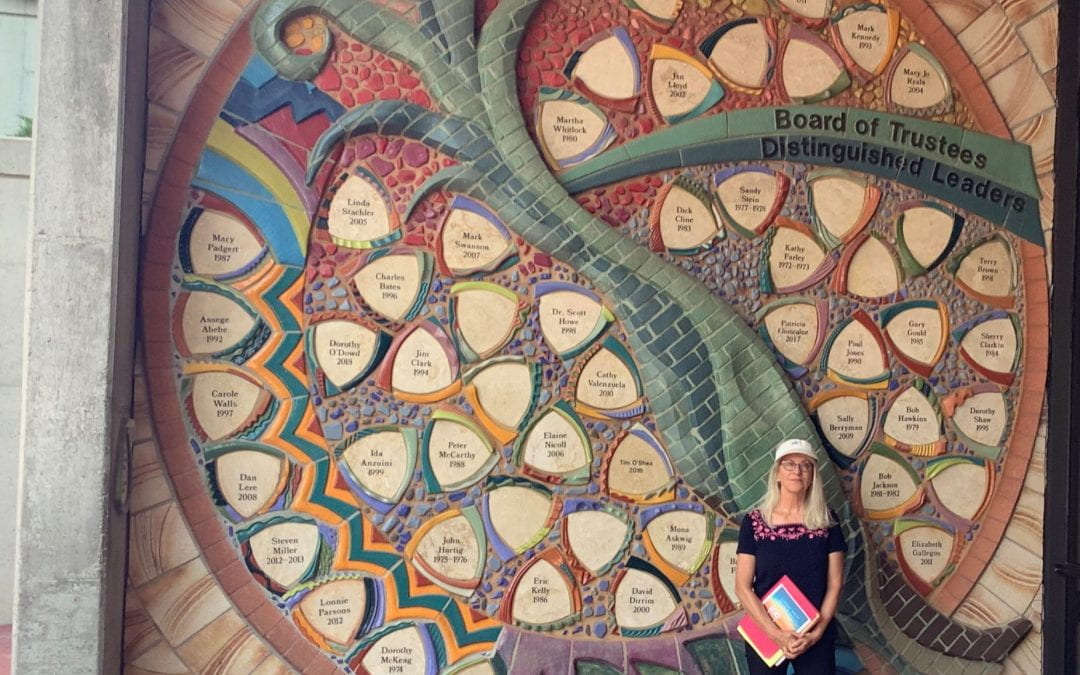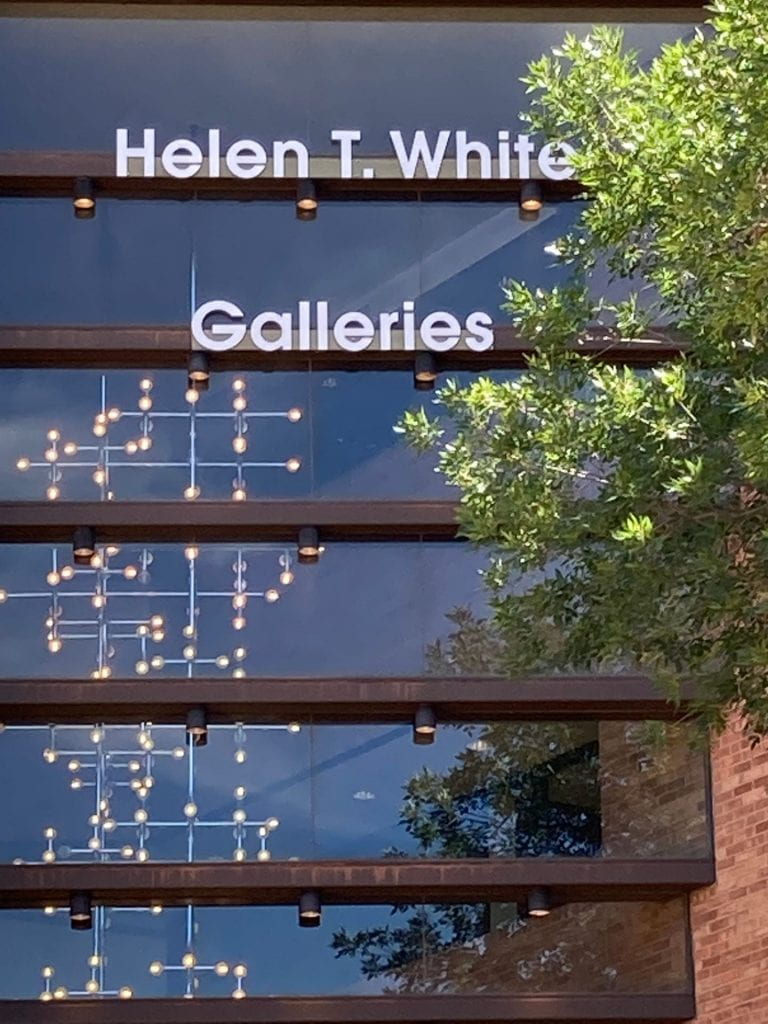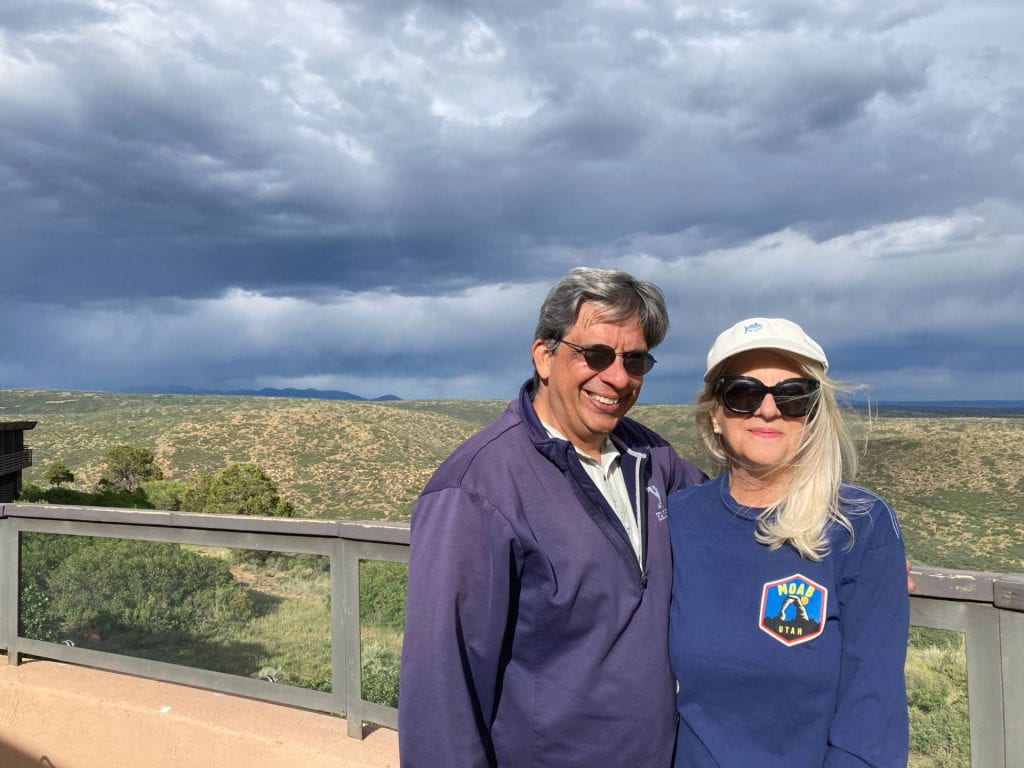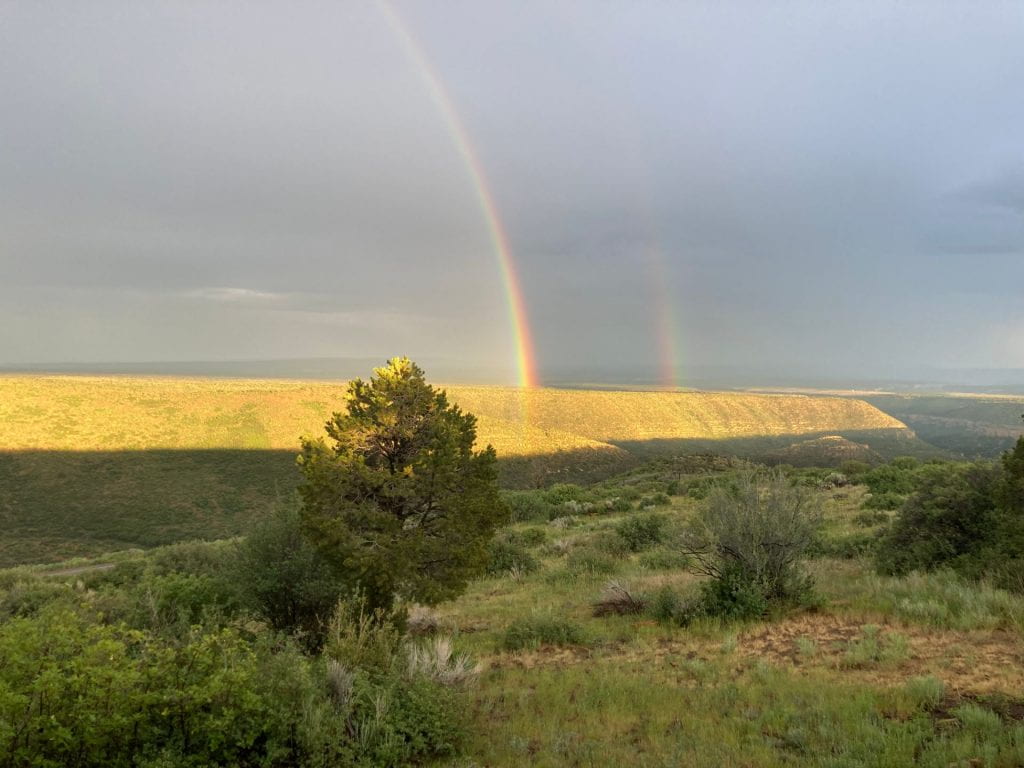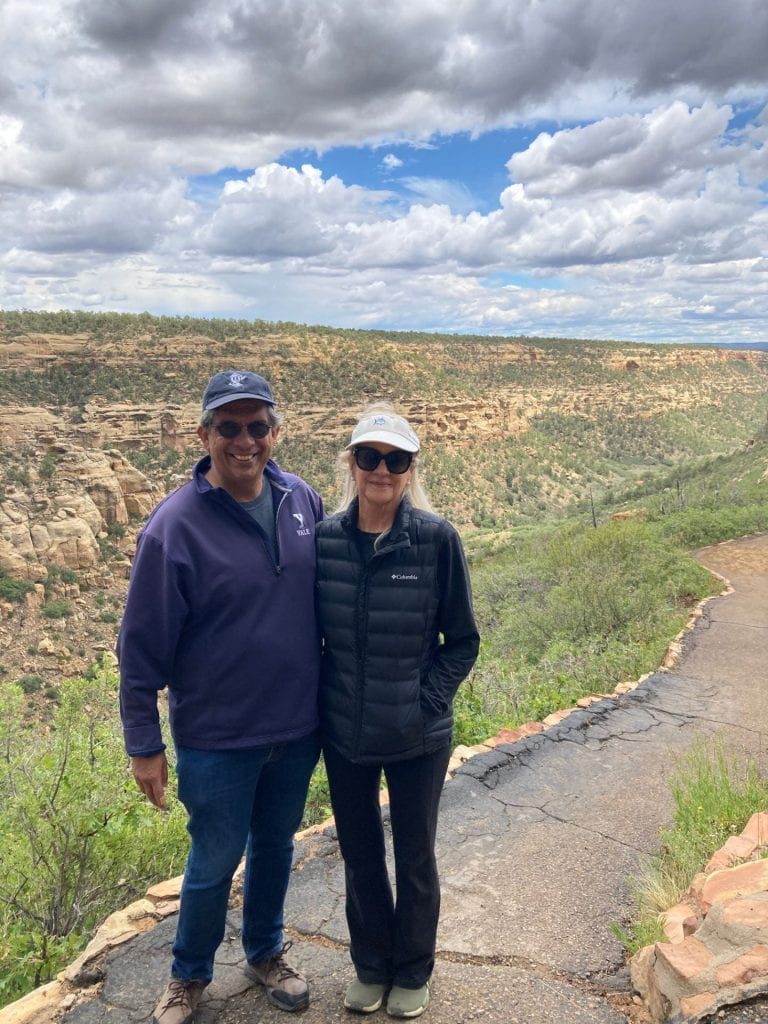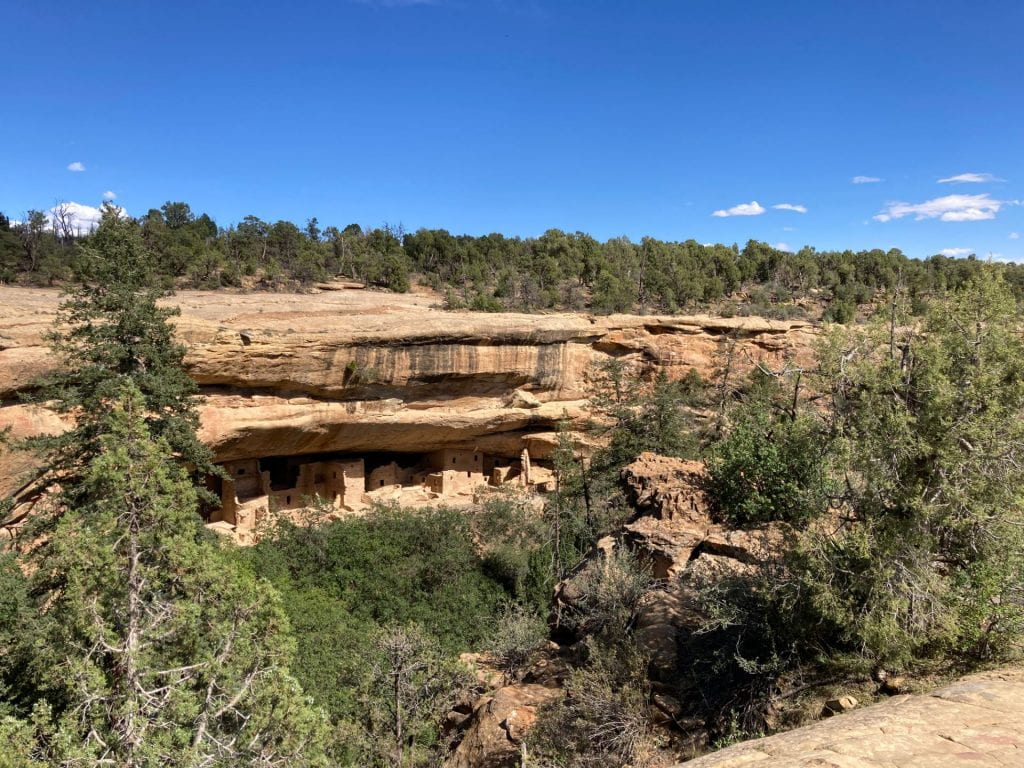The Sangre de Cristo Arts Center is the immediate “where of here,” a place meaningful for Pueblo and for me personally. We set ourselves up in the early morning cool in front of a colorful mosaic of inlaid polished stone. Each stone names a Distinguished Leader or Board Member of the Art Center’s complex of galleries, performance theatre, and children’s museum. I come from these people up on the wall, Helen White, Kathy Farley, Bob Jackson – the stories of their lives and aspirations are part of how my family tells about our Pueblo.
José and I have been seeing the sights, encountering “a new Pueblo.” What’s new is that we come to town and go directly to the El Pueblo Museum of History, because we’ve come from Mesa Verde, and Bend, Oregon, before that, with an impromptu detour in Ignacio at the Southern Ute Reservation. This time around, coming to Pueblo, we want to enter town not so much from memory but from an intention to arrive as us today.
We talk day and night about what’s different this visit versus last, talk that veers into feminist placemaking methodologies and what they ask all of us to think through and to write. I am taking stock of settler legacies, subjecting memory to fact and and that distance turns up unexpected angles for seeing borders of a polite childhood.
Again, José does the honors.
The Where of Here
José
Good morning. It’s June 30th, in Pueblo. We’re here with Krista, round two of the Living West as Feminists project. We’ve been seeing the sights, museums, and been impressed by the “new Pueblo” as Krista keeps saying.
I think it might be good to have you talk to us about the where of here, round two. Thinking again about methodologies of feminist placemaking and their assets. We are aware of your article in WAL, where you talk about “white trouble” and we have continued that conversation with Susan Bernardin in Corvallis, and Randi Tanglen has continued it herself working with Joanna Brooks in “Reframing Rural,” This summer, what are your thoughts?
Krista
Thanks, José! Well, we’ve been and I’ve been on a journey really since we left Bend, Oregon, to think more self-consciously and substantively about creating right relations with Indigenous people, with my Indigenous histories in my own home place here of Pueblo. We’ve been through Mesa Verde National Park. We were greeted in Pueblo, we drove directly to the El Pueblo Museum, which I can say more about, it’s such a big topic.
Right now we are at the Sangre de Cristo Art Center and Conference Center. We are in front of this art piece that commemorates leaders of Pueblo, people I knew or my parents knew when I was growing up.
We’re here, really in the heart of settler wealth. For much of my life I was close to Helen Thatcher White, people called her “Sitty,” who provided seed money for this Art Center, and for the El Pueblo Museum of History. I loved Sitty as a child and a teenager and into my 20s when she died. She was close to my aunt Adrian. They lived together more than twenty years in a home on (yes) Comanche Road. There was a lot of whispering about them, what kind of living together did they do? I thought of her as family. Certainly my aunt thought of her as family. My aunt took care of her until the end and I would come home as a young adult to see how things were going.
I came here to the Art Center because Sitty had a lot of Taos 10 artists which hung in their home. A major gift she gave to the Center allowed the gallery space to be built for the Francis King Western Art Collection. Some works now there include ones Sitty eventually donated. She was a Thatcher, banking money, she had been married and her husband died relatively young. Her sons, in particular the older son Butch, carried on the business, the Minnequa Banks. So I think of myself as linked to this Art Center through Sitty and my aunt and their homes. They had Remingtons and Sharps hanging on the walls, Sitty’s paintings. Eventually they hung art in a mountain place called “The Getaway” in Colorado City where we went to visit in the summers. Before I knew what “a Remington” or “a Sharp” was, I was schooled in the aesthetics of Western landscape, and I love those aesthetics. Like the memoirist Joanna Brookes, who you talked about in Randi’s “Reframing Rural” podcast, I can’t “unmix” that part of me and my history from who I am today.
So much of the Art Center is a story of women’s leadership and collaboration. How to do history, who is making history, those ideas had to change so anyone could conceive of women’s Junior League “volunteer” work in its proper lights. At the top of the mosaic, a commemorative stone recognizes Kathy Farley, the Center’s founder with her friend and other founder, Pat Kelly. I watched a recent video for Farley’s thoughts and celebrations of the Center’s Fiftieth Anniversary. Before today, what I remembered from teenage years is a story from my mother about a terrible assault she lived through. It was well before I understood how political rebellions might be punished or lived beyond. What I didn’t sufficiently ponder until this return is the extent to which Farley didn’t allow herself to be shut down, like lots of women of the early 1970s era of women’s liberation didn’t allow it. Including me. She’s the most known of the civic leaders who ultimately got the Center up and running, all of them motivating each other in building projects, fundraising campaigns, and getting art collections.
Last summer we were out on the Beulah Road, prairie land, where you interviewed me and I talked about how the picture window of that architecturally novel and gorgeous house of my grandparents had taught me or framed for me an aesthetic of Western landscape perception that goes to the core of what my work has been about as a scholar (I realize today) but also who I am as someone from the US West. Which is to say a deeply trained unconscious way of looking and being that are settler ways of perceiving land and place of course all at the heart of this project.
We’ve just come from Mesa Verde National Park into Pueblo, and we made a point of going to the El Pueblo Community Center and Museum as a way to honor some other rationale for homecoming, to do a kind of Land Acknowledgement. Arapaho, Ute, Comanches and especially the Ute people were and are here or near here. But we went to the El Pueblo Museum to begin there this time, not begin in the realm of personal memory, per se, but begin in the realm of a larger history. That museum was quite a wonder to walk into. I had no idea there was such a museum in Pueblo. This is the conversation we’ve been having about “the new Pueblo.”
Maybe it’s just new to me? I wonder. But we came this way, not following memory, as a way to do the reckoning we’ve been doing, that I have been doing, and José has accompanied me through it, with right relations, with Native history, and with the women of this project, actually.
The reckoning really came into focus when we left Bend, Oregon. We left that memorial, and I wrote a little about it in the last blog post. The people who were there with us – it was for my cousin Beau, and his two sons and sister Susie were there, and his aunt Leslie, from the Richmond side of the family. The grandmother, Alys Richmond has passed, and his uncle, Tom Richmond wasn’t there. I was close to both of them, Alys and Tommy when I went to live in Oregon at the Umpqua River. Anyway. . . what I learned is that Tom now talks about himself as Tututni, I never knew that, nobody talked that way when I spent time with them. He has been written about as a caretaker of the Umpqua River Ranch, he’s featured in a podcast series called the Evergreen project, “The Opposite Side of the River,” meaning the Umpqua River. He talks about being a descendant of Tututni peoples.
So we did a lot of reflecting on that after the memorial. We learned that others in that side of the family including my late cousin, his sister, aunt, and sons, are enrolled members of the Tolowa Dee-Ni’ nation (formerly the Smith River Rancheria). There was talk about the kinds of resources that have been made available to them, as enrolled members of that nation, including education, healthcare, rehab, and elder pay.
During the “time to share memories,” I wanted to say something that had perspective, about how it’s hard to remember anything was ever good when things goes very wrong. I wanted to say something for my Uncle whose house it was where we met up to share memories..So I said, as the oldest child, that I could remember before it was all trouble and bad things, back to when Beau was little and things were fun. I could remember him mom as a folk dancer who played piano and sang, she had perfect pitch. And his dad would accompany her on the banjo. There was music at the memorial, Beau wrote music and danced.
Beau’s friends came in from Portland and plugged in a piano and the woman sang one of Beau’s songs. The guy said: I would listen to Beau and think it couldn’t get any worse, Then it would get worse.
The day after we went to that greenspace to walk, only to realize it was “Pioneer Park.” It was sobering and very grief-stricken really in a way that went far beyond the loss of my cousin Beau and the extreme trauma in that family to the theft of land, the loss of land, and the impacts of that history. I don’t know that I’ve ever felt so viscerally what land theft is, and its legacies.
We went to Mesa Verde and spent five days, and heard the terrible news of Dobbs. And walked around in a daze but it was so beautiful. Then we went to Ygnacio on the way here, where the Southern Ute reservation is headquartered, then we came to the El Pueblo Museum, a museum that . . . it really is a moment to appreciate what colleagues’ work can do, what public history can do, since you look at the placards, and it’s clear that people at Colorado State University Pueblo, from History, from Geography, and from other disciplines have had a direct hand in creating the kinds of histories that are there. Your and my colleagues have done that work, we know some of the people.
Anyway. I came out of the Museum with a headache because I was holding back so many tears to think that this is Pueblo now. I always sensed it was there, but, but it really couldn’t be spoken, it was silenced or seemed to be denied in my family and family histories, without anyone deliberately intending that. I mean, I had to have been living very close to the people who had a hand in this overall history, very close.
José
You’ve told me some, before, about Kathy Farley, who was an early Director of the Arts Center. The story is so provocative, and goes to the larger stakes of this project, which is about the broader public humanities platform that you’re using, and you have practiced in your surf projects, but now you’re using it to think about the way that feminist scholars, feminist activists live out their feminism in the West.
Given the unfortunate disastrous decision a week ago, just about a week ago, from the Supreme Court to dismantle the last vestiges of Roe vs. Wade, and any protection for women’s rights to their bodies and to their reproductive rights. Everybody always says “we know it had been coming” but how has that news affected the way you’re thinking about what’s at stake here for you in this project as you go visit your feminist colleagues?
Krista
Thank you for redirecting me! What’s at stake here, at least this is what’s on my mind right now . . . is reckonings with whiteness and white supremacy as feminist accountability. My work for a long time has been informed fundamentally by critical race theory. And this more recent work has to do with thinking about whiteness as its own pervasive social logic not to critique, and not to, certainly not to defend ir, but to grapple with it. This project is an attempt to grapple with it. I’ve been thinking more explicitly about grappling with it as a settler, and working with concepts of feminist critical regionalism and significance of place to grapple with it as a settler, and to foreground settler history as an expression of white supremacy.
I’ve been sharing Margaret Jacobs book, After One Hundred Winters. To me, this is a very beautiful book, a very important book. It’s opening situates us as readers in northern Nebraskan farmlands with farmers who get their land through the Homestead Acts and Ponca people who have been removed further north in Nebraska. The farmers and Ponca make an alliance in the fight against the Keystone XL pipeline. The farmers come to realize the land they fight for is formerly Ponca land and over some time, they decide to repatriate to the Ponca a portion of their settler land. Margaret chronicles the story as a way to ask settlers what it means to reckon with certain histories? To bring those histories more to the fore of their work, and to think about forms of restoration or truth and reconciliation in which they themselves can participate.
The question has been on my mind about what it might mean to do the work of “acknowledgement,” of any form of restorative justice or reconciliation. Because the gift is also for settlers, profoundly. To restore in any way a right relation. On the way from Mesa Verde to Pueblo, and on the journey we took to the Ute nation, to the Southern Ute Cultural Center and Museum. We didn’t know what we were doing really, we were figuring it out as we went along. And the museum was closed that day. But we got a glimpse of the world being lived there now. The gorgeous museum sits alongside the Sky Casino Hotel Resort, and across from the museum is a gleaming, brand new Southern Ute Health Center. On the way into town we saw a long line of cars and a sign: Ute Food Distribution Monday.
So I’ve been thinking about right relations. BLM lands are everywhere around that area, and I was reading about the ways that those lands are not available for Ute people to either do ceremony or to utilize natural resources for water, for grazing. or other kinds… So some of the BLM, the classic BLM interface with Native communities, both
And as I was saying before, Randi’s work in her talks, and Susan too, talking about the impossibility of unmixing legacies of injury, of being actors of oppression, and the worst kinds of violence, settler white supremacist violence, of dispossession, and being agents of genocide. And having in those kinds of family also histories of generosity and of wellness. Those to me are important questions. And they’re wrapped up in what feminist accountabilities are and what can do.
Do you want to say anything here, at the end?
José
I’m reminded by your blog, which this summer began with family and family relations, that those relations are expanding the project in the sense of connectivity and possibility and futurity. I think all that is very hopeful.
I think that what’s so disturbing about Roe is that it goes against the grain of not just family relations, ironically, but it also licenses this deep unsettledness among many communities, especially white communities, that hurtfulness and woundedness are things to project onto others, especially Others of color. So I take heart in your project and my participation in the project and your making connection there.
It does seem to me that we’re literally driving through parts of the country where some rationale for hurtfulness as a way of being, a way of experiencing the world has taken very deep root. I think there is a need for not just solidarity but solidarity and the task of healing, healing everybody that we encounter. And I think that dovetails with climate change as well. The need to heal so that we understand how best to live a more sustainable life. It’s an emotional time. And I’m glad I’m on the road with you on these issues.
